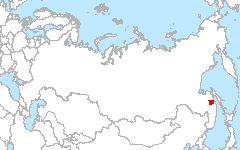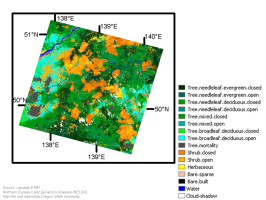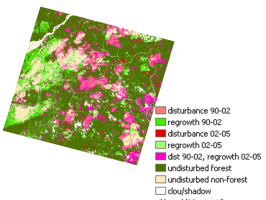 Sikhote-Alin
50.3°N 138.9°E
Sikhote-Alin
50.3°N 138.9°E
Russian Federation: Northern part of the Sikhote-Alin Mountain range and the south-eastern part of Khabarovsky Krai.
Site Investigators
- Tatiana Loboda, University of Maryland
- Guoqing Sun , University of Maryland
- Zhiyu Zhang, University of Maryland
Site Description
The site is located in a transition zone between middle taiga and temperate forests of the northern Sikhote-Alin Mountains. The site stretches between the Amur river in the west as it turns north-east and away from the border between Russia and China and the Tatar Strait of the Sea of Japan in the east. Elevations range between 200 and 2000m with the mean elevation around 600m. Although found below 50° N ecosystems within this site developed in cold alpine conditions due to presence of the Sikhote-Alin Mountain range with mean annual temperatures ranging between -5 to 0°C (Stolbovoi and McCallum, 2002). Only flat areas in the western part of the site along the Amur River have mean annual temperatures between 0 and 5°C. Although this area is immediately adjacent to the Sea of Japan and should experience the influence of the warm Kuroshio current in the west Pacific, the dominance of the Siberian High during winter months amplified by the altitudinal gradient supports mean January temperatures between -20°C at lower elevations and -25°C at higher elevations. Mean July temperatures vary considerably between the lower elevations (19 – 21°C) and higher elevations (10-12°C). The area receives abundant amount of precipitation (500-700 mm) brought in by the summer monsoon with increased precipitation rate driven by the topographic barrier established by the Sikhote-Alin mountains. This is one of few regions in Northern Asia where permafrost is absent everywhere except at the highest elevations. The site has one of the highest total phytomass densities in Russia (on average above 7 km/m2 with some areas above 12.6 km/m2) (Stolbovoi and McCallum, 2002). The majority of phytomass is contained in the above ground layer (up to 4 times as much as above ground). Larch and spruce-fir forest are dominant communities. However, oak, birch and aspen are also found throughout the area. The region is generally a biodiversity hotspot including such highly endangered species as the Amur Tiger.
Download
- Site Report (3.2 MB - PDF)
- Land Cover (preview - 559kB,png) (data - 10.6MB, geoTiff.zip)
- Land Cover Change (preview - 681kB,png) (data - 4.9MB, geoTiff.zip)
- Source Landsat imagery available via LARSE Image Database
Global Map Analysis


